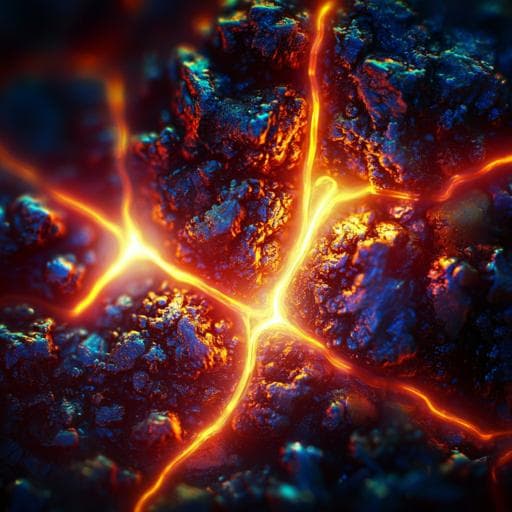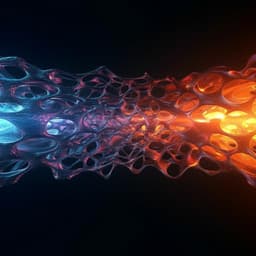
Physics
Electronic response of a Mott insulator at a current-induced insulator-to-metal transition
C. T. Suen, I. Marković, et al.
The study delves into the fascinating insulator-to-metal transition of Ca₂RuO₄ induced by d.c. current, conducted by the research team led by C. T. Suen and others. Utilizing transport-ARPES, they reveal a pronounced reduction of the Mott gap and significant modifications in Ru band dispersion, emphasizing the unique phase transition dynamics between lattice structures and electronic responses.
~3 min • Beginner • English
Introduction
Ca₂RuO₄ is a quasi-two-dimensional Mott insulator composed of RuO₆ octahedral layers that undergoes a first-order insulator-to-metal transition (IMT) at T_IMT ≈ 357 K upon heating. The low-temperature insulating S phase (shorter c axis) and the high-temperature metallic L phase (longer c axis) differ structurally due to octahedral tilts and distortions that lift the t2g degeneracy and open a Mott gap. The ground state is highly sensitive to external perturbations—chemical substitution, pressure, strain, electric fields, and d.c. current can all tune the IMT. A d.c.-current-driven IMT produces a long-lived steady metallic state (denoted L*) as long as current flows, with structural changes distinct from the thermal L phase (S* and L* have slightly larger and smaller c axes, respectively, relative to their zero-current counterparts) and suppression of antiferromagnetism below T_N ≈ 110 K. A key open question is the microscopic electronic mechanism by which current induces the IMT and whether the resulting electronic structure is identical to that of the thermally driven metallic phase. The study aims to directly track the electronic structure under applied current and to disentangle intrinsic current-induced changes from artifacts of stray electric and magnetic fields, thereby clarifying the role of lattice–orbital coupling and the distinctness of the current-induced metallic state.
Literature Review
Prior work established the structural origins of the zero-current IMT in Ca₂RuO₄ via c-axis shortening and octahedral distortions, with extensive studies of temperature, chemical substitution, pressure, strain, and electric/electrostatic control of the IMT. Current-stabilized nonequilibrium phases exhibit distinct lattice parameters (S*, L*) and suppressed antiferromagnetism, with nano-resolved studies revealing metal–insulator nanostripes for intermediate b-axis current densities. Raman, X-ray absorption/emission, and transport studies debated the role of Joule heating versus intrinsic current effects. Methodological challenges for in-operando ARPES include stray fields that can shift and broaden spectra; recent conceptual and instrumental advances have sought to access spectral functions in current-carrying devices. Theoretical descriptions using Landau theory and DMFT have connected lattice energetics to electronic correlations in Ca₂RuO₄, but a comprehensive picture of current-driven electronic structure changes remained incomplete.
Methodology
- Experimental approach: Combined four-probe electrical transport with angle-resolved photoemission spectroscopy (transport-ARPES) to probe electronic structure under steady d.c. current.
- Sample preparation and characterization: High-quality Ca₂RuO₄ single crystals grown by optical floating zone; characterized by Laue diffraction and SQUID magnetometry (T_N ≈ 110 K). Crystals shaped ~2 × 1 × 0.25 mm³ for homogeneous current paths.
- ARPES setups: Zero-current S phase measured at Canadian Light Source (QMSC) at T = 180 K; transport-ARPES at ALS MAESTRO (v7.0.2) with four-probe configuration (Keithley 2400) and current applied along the crystallographic b axis. Measurements at 74 eV with σ- and π-polarized light; cleaves performed in UHV. High-temperature zero-current L phase measured at T ≈ 380–384 K with identical photon energy and polarization.
- Mitigating stray fields: Addressed magnetic-field-induced rigid k-shifts by aligning high-symmetry points to known k-space positions; handled electric potential gradients by (i) spatially mapping Ca 3p core-level binding energy along current flow to quantify local potential and homogeneity, and (ii) using micrometre-scale (15 µm) beamspot to minimize energy broadening. Established a common binding-energy reference across current states by aligning Ca 3p core levels.
- Energy-shift and broadening quantification: Extracted core-level shifts of ~4.5 eV (S→S*) and ~1.6 eV (S→L*); estimated current-induced broadening across 15 µm spot ~75 meV, enabling resolution of gap-scale shifts (S-phase gap ≈ 0.4 eV).
- Momentum- and energy-resolved mapping: Acquired Fermi surfaces and dispersions along orthorhombic Brillouin zone edges (XM and YM) with analyzer slit aligned along b (XM) and a (YM) axes, maintaining σ-polarization. Compared current-on (L*) to current-off (S) and to high-temperature L phase.
- Theoretical calculations: Performed single-shot DFT+DMFT using crystallographically refined structures for S, S*, L*, L (from neutron diffraction). VASP PBE-GGA DFT, downfolding to t2g Wannier basis (−2 to +1 eV), including noncubic crystal fields and SOC; Kanamori interactions with U = 1.9 eV, J = 0.4 eV. CT-HYB QMC impurity solver (TRIQS); maximum-entropy analytic continuation to obtain real-frequency self-energies and spectral functions. DMFT accounted for current implicitly via current-induced lattice constants of S*, L*.
- Landau free-energy analysis: Constructed an effective Landau theory with electronic order parameter φ = (n_xy − n_yz)/(n_xy + n_yz) and an auxiliary parameter η = α(n_xy − n_yz) to encode electric-field-induced directionality and orthorhombicity. Expanded free energy F(φ,η) to fourth order, with symmetry-allowed couplings; parameters chosen to reproduce (i) a second-order transition to tetragonal at ~420 K and (ii) first-order IMT features. Mapped phase boundaries versus temperature and effective field and tracked minima across phases (S, S*, L*, L).
Key Findings
- Clear current-induced gap reduction and emergence of spectral weight at E_F in Ca₂RuO₄:
- ARPES shows momentum-dependent spectral weight at E_F in L*; zone-integrated spectral weight A(ω) indicates a global reduction of the charge gap (S vs L*).
- Gap reduction becomes evident only after fully crossing the IMT (zero → intermediate → high current), with spectral weight redistribution toward lower binding energies across Ru and O valence bands.
- Quantified stray-field corrections: Ca 3p core-level shifts of ~4.5 eV (S to S*) and ~1.6 eV (S to L*); current-induced energy broadening ~75 meV with 15 µm spot; insulating S-phase gap scale ~0.4 eV.
- Anisotropic modification of Ru band dispersions across the IMT:
- Along XM (b-axis direction), current increases spectral weight near X close to E_F and depletes spectral weight at k* ≈ ±0.38 Å⁻¹; S-phase shows flat Ru bands dispersing down to X and lying below E_F, whereas L* shows enhanced intensity at X and reduced weight at k*.
- Along YM (a-axis direction), Ru dispersion exhibits little to no change across IMT; MDC and EDC shapes remain similar, with redistribution from higher- to lower-energy Ru bands but no clear dispersion modification.
- The XM vs YM contrast correlates with larger b-axis lattice change (Δb_S−L ≈ 0.2 Å) versus a-axis (Δa_S−L ≈ 0.04 Å), indicating strong coupling between decreased orthorhombicity and electronic anisotropy; L* appears more isotropic than S.
- Distinctness of current-induced L* vs thermal L phase (rules out simple Joule heating):
- L* Fermi surface exhibits geometry-dependent anisotropy (σ-polarized measurements differ for analyzer orientation along a vs b), while thermal L phase shows near isotropy for both orientations (consistent with reduced orthorhombicity), beyond thermal broadening effects.
- MDCs at the Brillouin zone edge show strong intensity at M points for L*, whereas the high-T L phase peaks near the zone center and diminishes toward edges, evidencing different Fermiology.
- Theory support and discrepancies:
- DMFT using current-induced lattice parameters reproduces metallic Fermi surface and integrated spectral function trends (gap reduction), and qualitatively captures intensity increase at X and redistribution between lower/upper Ru bands across the IMT along XM. Calculated XM and YM dispersions are more similar than observed, suggesting additional correlation effects or matrix elements not fully captured.
- Landau free-energy analysis with electronic order parameter φ and field-directional η yields a phase diagram with first- and second-order boundaries; demonstrates that an orbitally driven electronic response must cooperate with lattice distortions to drive the field-induced IMT. The analysis qualitatively accounts for L* being an electronically distinct steady state from L.
- Transport and device-quality indicators:
- I–V curves display negative differential resistance characteristic of the current-induced IMT, indicating homogeneous current flow. Spatial mapping of core-level shifts identifies regions suitable for ARPES (smooth potential gradients) and excludes cracked/inhomogeneous areas.
Discussion
The results directly address the key question of how d.c. current drives the IMT in Ca₂RuO₄ and whether the current-stabilized metallic state is equivalent to the thermally driven metallic phase. By correcting for stray fields via core-level alignment with a micrometre-scale beamspot, transport-ARPES reveals intrinsic changes: a global reduction of the Mott gap and a selective modification of Ru band dispersion only along the b-axis-related XM direction. This anisotropy correlates with the larger structural response (Δb ≫ Δa), highlighting that the current couples strongly to the lattice and orbits, reducing orthorhombicity and reshaping low-energy bands. The absence of similar changes along YM and the distinct Fermi surface compared to the high-T L phase confirm that the L* state is not a trivial consequence of Joule heating but an electronically distinct steady state. DMFT using current-induced lattice parameters supports the emergence of metallic spectral weight and aspects of the XM intensity redistribution, while deviations (especially the XM–YM anisotropy) suggest that additional correlation or matrix-element effects, and the nonequilibrium nature of the current-carrying state, warrant more advanced theoretical treatment. The Landau free-energy framework incorporating an electronic order parameter φ and a field-directional η captures the interplay of lattice and orbital degrees of freedom and qualitatively reproduces the field- versus temperature-driven phase boundaries, reinforcing that both lattice and orbital polarization must act in concert to drive the current-induced IMT.
Conclusion
This work establishes transport-ARPES as a powerful probe of current-driven phase transitions and unveils the electronic structure of the current-stabilized metallic state in Ca₂RuO₄. After rigorously correcting for stray-field artifacts using core-level energetics and a micrometre-scale beam, we demonstrate a current-induced reduction of the Mott gap and an anisotropic modification of Ru band dispersions confined to the b-axis-related XM direction, consistent with strong coupling between lattice orthorhombicity and orbital-dependent electronic states. Comparative ARPES shows that the current-induced metallic L* state is electronically distinct from the high-temperature L phase, ruling out simple Joule heating. DMFT using current-induced lattice parameters captures key trends, and a Landau free-energy analysis with electronic and field-directional order parameters qualitatively explains the phase behavior. Future research should develop fully nonequilibrium many-body approaches (e.g., nonequilibrium DMFT) including explicit current flow and matrix-element effects, explore different current directions and strain combinations, and extend transport-ARPES to other correlated systems to map how lattice–orbital coupling governs current-induced transitions.
Limitations
- Residual uncertainty in separating electrostatic versus chemical core-level shifts (estimated ≤ ~100 meV) could weakly affect absolute energy alignment, though not the main conclusions.
- Finite beamspot averages over potential gradients, causing ~75 meV broadening under current; larger spots would further smear features.
- Standard ARPES cannot access unoccupied states; interpretations near E_F and above rely on theory.
- Potential sample-to-sample variability in critical currents and structural responses; care taken to avoid intermediate nanostripe regimes, but mesoscopic inhomogeneities cannot be entirely excluded.
- DMFT reproduces several qualitative trends but underestimates XM–YM anisotropy, indicating limitations of equilibrium-based theory and the need for explicit nonequilibrium treatments.
- Magnetic-field-induced k-shifts and matrix-element effects are corrected or controlled but may introduce small systematic uncertainties.
Related Publications
Explore these studies to deepen your understanding of the subject.







